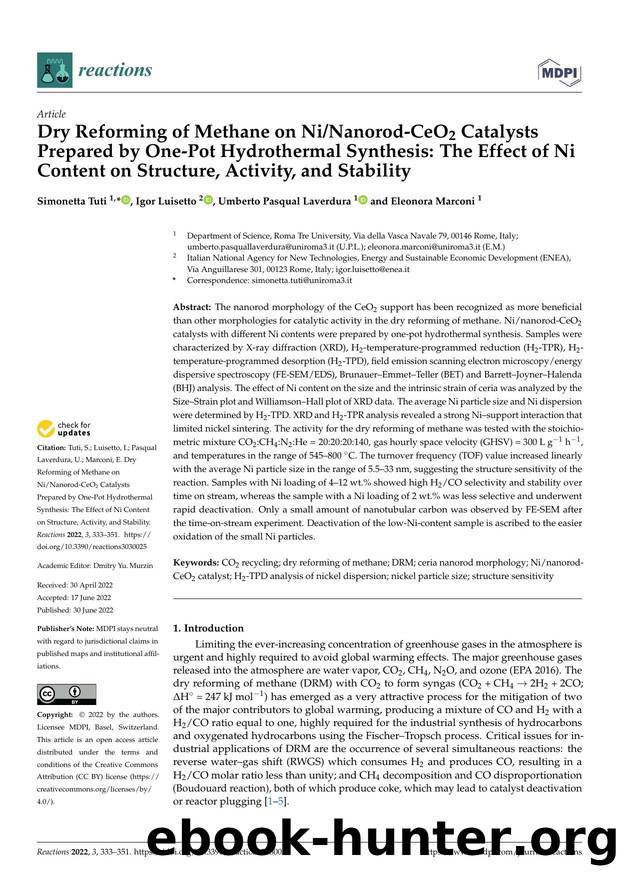Dry Reforming of Methane on NiNanorod-CeO2 Catalysts Prepared by One-Pot Hydrothermal Synthesis: The Effect of Ni Content on Structure, Activity, and Stability by Simonetta Tuti Igor Luisetto Umberto Pasqual Laverdura & Eleonora Marconi

Author:Simonetta Tuti, Igor Luisetto, Umberto Pasqual Laverdura & Eleonora Marconi
Format: pdf
Tags: The nanorod morphology of the CeO2 support has been recognized as more beneficial than other morphologies for catalytic activity in the dry reforming of methane. Ni/nanorod-CeO2 catalysts with different Ni contents were prepared by one-pot hydrothermal synthesis. Samples were characterized by X-ray diffraction (XRD), H2-temperature-programmed reduction (H2-TPR), H2-temperature-programmed desorption (H2-TPD), field emission scanning electron microscopy/energy dispersive spectroscopy (FE-SEM/EDS), Brunauer–Emmet–Teller (BET) and Barrett–Joyner–Halenda (BHJ) analysis. The effect of Ni content on the size and the intrinsic strain of ceria was analyzed by the Size–Strain plot and Williamson–Hall plot of XRD data. The average Ni particle size and Ni dispersion were determined by H2-TPD. XRD and H2-TPR analysis revealed a strong Ni–support interaction that limited nickel sintering. The activity for the dry reforming of methane was tested with the stoichiometric mixture CO2:CH4:N2:He = 20:20:20:140, gas hourly space velocity (GHSV) = 300 L g-1 h-1, and temperatures in the range of 545–800 C. The turnover frequency (TOF) value increased linearly with the average Ni particle size in the range of 5.5–33 nm, suggesting the structure sensitivity of the reaction. Samples with Ni loading of 4–12 wt.% showed high H2/CO selectivity and stability over time on stream, whereas the sample with a Ni loading of 2 wt.% was less selective and underwent rapid deactivation. Only a small amount of nanotubular carbon was observed by FE-SEM after the time-on-stream experiment. Deactivation of the low-Ni-content sample is ascribed to the easier oxidation of the small Ni particles., CO2 recycling; dry reforming of methane; DRM; ceria nanorod morphology; Ni/nanorod-CeO2 catalyst; H2-TPD analysis of nickel dispersion; nickel particle size; structure sensitivity
Download
This site does not store any files on its server. We only index and link to content provided by other sites. Please contact the content providers to delete copyright contents if any and email us, we'll remove relevant links or contents immediately.
Hit Refresh by Satya Nadella(9038)
The Compound Effect by Darren Hardy(8808)
Change Your Questions, Change Your Life by Marilee Adams(7635)
Nudge - Improving Decisions about Health, Wealth, and Happiness by Thaler Sunstein(7615)
The Black Swan by Nassim Nicholas Taleb(7010)
Deep Work by Cal Newport(6880)
Daring Greatly by Brene Brown(6446)
Rich Dad Poor Dad by Robert T. Kiyosaki(6403)
Principles: Life and Work by Ray Dalio(6213)
Playing to Win_ How Strategy Really Works by A.G. Lafley & Roger L. Martin(5922)
Man-made Catastrophes and Risk Information Concealment by Dmitry Chernov & Didier Sornette(5921)
Digital Minimalism by Cal Newport;(5664)
Big Magic: Creative Living Beyond Fear by Elizabeth Gilbert(5612)
The Myth of the Strong Leader by Archie Brown(5425)
The Slight Edge by Jeff Olson(5346)
Discipline Equals Freedom by Jocko Willink(5285)
The Motivation Myth by Jeff Haden(5156)
Stone's Rules by Roger Stone(5026)
The Laws of Human Nature by Robert Greene(4999)
